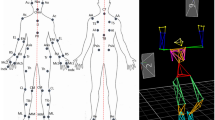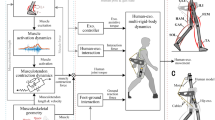Abstract
The neurophysiological mechanisms involved in postural stabilization are not well understood. Active and passive mechanisms at muscle and spinal levels as well as visual and vestibular processes are known to contribute toward postural stabilization and coordination of voluntary movement. The motivation for this research is to use a modeling–simulation framework to achieve two aims: (a) to ascertain viability of a physiologically motivated optimal controller design in the maintenance of posture and coordination of voluntary movement and (b) to study the relative contribution from active (feedforward) and passive (feedback) mechanisms in the execution of said movement. We employ a multi-segment sagittal model built on anatomical proportions with three degrees of freedom, including rotation at the ankle, knee, and hip joints. The behavior of the biomechanical model is controlled by an optimal linear quadratic regulator whose state and control weights are derived from physiological considerations. Representative postural and voluntary movements are simulated to illustrate the analysis–synthesis framework of biomechanical movement. Our analytical and simulation results support an active–passive model of postural stabilization and movement coordination. Besides expanding our understanding of the physiological stabilization processes in the body, the insight gained from this study promotes awareness of the existence of optimizing controllers in the central nervous system.












Similar content being viewed by others
References
Peterka RJ. Postural control model interpretation of stabilogram diffusion process. Biol Cybern. 2000;82:335–43.
Peterka RJ. Sensorimotor integration in Human Postural Control. J Neurophysiol. 2006;88:1097–118.
Van Soest AJ, Haenen WP, Rozendaal LA. Stability of bipedal stance: the contribution of cocontraction and spindle feedback. Biol Cybern. 2003;88:93–301.
Maurer C, Mergner T, Peterka RJ. Multisensory control of human upright stance. Exp Brain Res. 2006;171:231–50.
Nashner LM, McCollum G. The organization of human postural movements: a formal basis and experimental synthesis. Behav Brain Sci. 1985;8:135–72.
Horak FB, Nashner LM. Central programming of postural movements: adaptation to altered support-surface configurations. J. Neurophysiology. 1986;55:1369–81.
Maki BE, McIlroy WE. The role of limb movements in maintaining upright stance: the change-in-support strategy. Phys Ther. 1997;77:488–507.
Winter DA, Patla AE, Prince F, Ishac M, Gielo-Perczak K. Stiffness control in quiet standing. J Neurophysiol. 1998;80:1211–21.
Todorov E, Jordan MI. Optimal feedback control as a theory of motor coordination. Nat Neurosci. 2002;5:1226–35.
Schaal S, Schweighofer N. Computational motor control in humans and robots. Curr Opin Neurobiol. 2005;15:675–82.
Harris CM, Wolpert DM. Signal-dependent noise determines motor planning. Nature. 1998;394:780–4.
Kuo AD. An optimal control model for analyzing human postural balance. IEEE Trans Biomed Eng. 1995;42:87–101.
Kuo AD. An optimal state estimation model of sensory integration in human postural balance. J Neural Eng. 2005;2:235–49.
Pandy M. Computer modeling and simulation of human movement. Annu Rev Biomed Eng. 2001;3:245–73.
Van der Helm FCT, Rozendaal L. Musculoskeletal Systems with Intrinsic and Proprioceptive Feedback. In: Winters JM, Crago PE, editors. Biomechanics and neural control of movement and posture. New York: Springer-Verlag; 2000. p. 164–74.
Barin K. Evaluation of a generalized model of human postural dynamics and control in the sagittal plane. Biol Cybern. 1989;61:37–50.
Pai YC, Iqbal K. Simulated movement termination for balance recovery: can movement strategies be sought to maintain stability even in the presence of slipping or forced sliding? J. Biomechanics. 1999;32:779–86.
Iqbal K, Pai YC. Predicted region of stability for balance recovery: motion at knee joint can improve termination of forward movement. J. Biomech. 2000;33:1619–27.
Kerr KM, White JA, Barr DA, Mollan RAB. Analysis of sit-to-stand movement cycle in normal subjects. Clin Biomech. 1997;12:236–45.
Resiman DS, Scholz JP, Schöner G. Coordination underlying the control of whole body momentum during sit-to-stand. Gait Posture. 2002;15:45–55.
Scholz JP, Resiman DS, Schöner G. Effects of varying task constraints on solutions to joint coordination in a sit-to-stand task. Exp Brain Res. 2001;141:485–500.
Mughal AM, Iqbal K. “A fuzzy biomechanical model with H2 optimal control of sit-to-stand movement”, Proceedings of the 2006 American control conference, Minneapolis, MN; 2006. pp. 3427–3432.
Mughal AM, Iqbal K. “A comparison of fuzzy model based optimal control systems for biomechanical sit-to-stand movement”, Proceedings of the IEEE international conference on engineering of intelligent systems, Islamabad, Pakistan; 2006.
Jo S, Massaquoi SG. A model of cerebellum stabilized and scheduled hybrid long-loop control of upright balance. Biol Cybern. 2004;91:188–202.
Jo S, Massaquoi SG. A model of cerebrocerebello-spinomuscular interaction in the sagittal control of human walking. Biol Cybern. 2007;95(3):279–307.
Mughal AM, Iqbal K. “Active control vs. passive stiffness in posture and movement coordination”, IEEE International conference on systems, man and cybernetics, Montreal, 2007. pp. 3372–3376.
Winter DA. Biomechanics and motor control of human movement. New York: Wiley; 1990.
Brooks V. The neural basis of motor control, Chapter 4. Oxford: Oxford University Press; 1986.
Keshner E, Allum J. “Muscle activation patterns coordinating postural stability from head to foot” In Multiple muscle systems: biomechanics and movement organization, New York: Springer-Verlag; 1990. pp. 481–497.
Mughal AM, Iqbal K. “Synthesis of angular profiles for bipedal sit-to-stand movement”, 40th southeastern symposium on system theory, New Orleans, LA, 2008.
Mihelj M, Munih M, Ponikvar M. Human energy: optimal control of disturbance rejection during constrained standing. J Med Eng Technol. 2003;27:223–32.
Feldman AG. Functional tuning of the nervous system with control of movement or maintenance of a steady posture. ii. controllable parameters of the muscle. Biophysics. 1996;11:565–78.
Shadmehr R. The equilibrium point hypothesis for control of movement. Baltimore, MD: Department of Biomedical Engineering, Johns Hopkins University; 1998.
Gottlieb GL. Rejecting the equilibrium-point hypothesis. Mot Control. 1998;2:10–2.
Gomi H, Kawato M. Equilibrium-point control hypothesis examined by measured arm stiffness during multijoint movement. Science. 1996;272:117–20.
Cecilia L, Roland J. Bio-inspired sensory-motor coordination. Auton Robots. 2008;25:1–2.
Cecilia L, Gioel A, Eugenio G, Giancarlo T, Roland J, Hitoshi K, Zbigniew W, Maria C, Paolo D. A bio-inspired predictive sensory-motor coordination scheme for robot reaching and preshaping. Auton Robots. 2008;25:85–101.
Acknowledgments
This work was supported in part by a grant from the Arkansas Science and Technology Authority.
Author information
Authors and Affiliations
Corresponding author
Appendix
Appendix
The inertial, Coriolis, and gravitational matrices appearing in the nonlinear dynamic model (1) are given as [18]:
Rights and permissions
About this article
Cite this article
Mughal, A.M., Iqbal, K. Physiological LQR Design for Postural Control Coordination of Sit-to-Stand Movement. Cogn Comput 4, 549–562 (2012). https://doi.org/10.1007/s12559-012-9160-5
Received:
Accepted:
Published:
Issue Date:
DOI: https://doi.org/10.1007/s12559-012-9160-5




